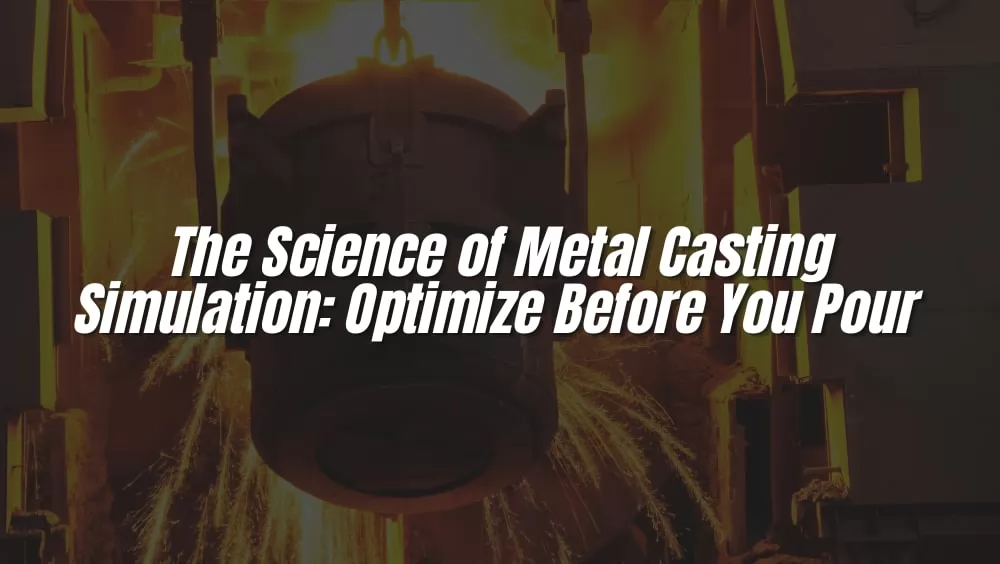
Imagine a foundry where every pour is perfect, with no defects or wasted metal. Metal casting simulation makes this possible, using virtual models to predict how molten metal behaves before it’s poured. It’s a game-changer for manufacturers aiming for precision.
This technology lets engineers test designs, spot flaws like porosity, and optimize processes without costly trials. From car parts to turbine blades, simulation saves time and boosts quality. It’s not just a tool—it’s the future of casting.
Ready to see how simulation transforms foundries? Let’s explore its benefits, applications, and why it’s a must for staying competitive.
Contents
- What Is Metal Casting Simulation?
- Why Is Simulation Critical for Foundries?
- Key Parameters Simulated
- Benefits of “Optimize Before You Pour”
- Industry Applications
- Common Challenges and How to Overcome Them
- Future of Metal Casting Simulation
- Conclusion
What Is Metal Casting Simulation?
Metal casting simulation uses advanced software to create virtual models of the casting process, replicating the behavior of molten metal as it flows, cools, and solidifies within a mold. By leveraging computational tools like finite element analysis (FEA) and computational fluid dynamics (CFD), simulation software predicts how a casting will perform under real-world conditions.
These simulations are powered by sophisticated algorithms that model physical phenomena such as fluid dynamics, heat transfer, and material stress. Manufacturers input design parameters—like mold geometry, material properties, and pouring conditions— into the software, which then generates a digital "preview" of the casting process. This virtual approach allows engineers to identify potential issues, such as air entrapment or shrinkage, long before physical production begins.
Why Simulation Is Critical for Foundries
Simulation is essential for foundries facing demands for high-quality castings, cost efficiency, and rapid production. Traditional physical trials are costly, slow, and error-prone, but simulation offers a virtual environment to optimize designs with precision. Here’s why it’s critical:
| Benefit | Summary | Example |
|---|---|---|
| Defect Prevention | Detects issues like porosity and shrinkage early. | Aerospace foundries avoid inclusions. |
| Cost Efficiency | Reduces prototypes and revisions. | Pump housing gating tested virtually. |
| Time Savings | Speeds development cycles. | Engine block cooling simulated for deadlines. |
| Sustainability | Minimizes waste and energy use. | Wind turbine scrap reduced. |
| Process Innovation | Models complex variables for better control. | Lightweight EV castings developed. |
1. Defect Prevention
Simulations detect issues like porosity, shrinkage, or hot spots before casting, ensuring high-quality parts. For example, a foundry making aerospace components can identify flow issues to avoid inclusions.
2. Cost Efficiency
Virtual testing reduces the need for expensive physical prototypes and mold revisions, saving materials and labor. A foundry producing pump housings can test gating designs virtually, cutting costs.
3. Time Savings
Rapid design iterations shorten development cycles, speeding up time-to-market. For instance, simulating engine block cooling helps meet tight automotive deadlines.
4. Sustainability
Optimized processes minimize material waste and energy use. A foundry casting wind turbine parts can reduce scrap, lowering environmental impact.
5. Process Innovation
Simulations model complex variables like alloy behavior or mold temperature, enabling precise control and innovation, such as lightweight castings for electric vehicles.
Suggestion:
By replacing guesswork with predictive accuracy, simulation empowers foundries to deliver reliable, cost-effective, and sustainable castings, maintaining a competitive edge in industries like automotive and aerospace.
Key Parameters Simulated in Casting
Casting simulation enables foundries to model critical parameters, predict issues, and optimize designs without costly physical trials. By simulating key aspects of the casting process, engineers can ensure high-quality results. Below are the essential parameters simulated and their importance.
1. Molten Metal Flow
This tracks how liquid metal fills the mold, identifying turbulence or incomplete filling that could cause defects like inclusions. For example, simulating flow for an automotive cylinder head helps optimize gating to prevent air entrapment.
2. Solidification
Solidification simulation predicts how metal cools and solidifies, preventing shrinkage or voids. For a steel gear, it ensures uniform solidification to avoid internal defects, enhancing strength.
3. Heat Transfer
Heat transfer modeling tracks temperature distribution to avoid hot spots or thermal stress. In aluminum engine block casting, it ensures consistent cooling to prevent cracks or warping.
4. Stress and Deformation
This evaluates mechanical stresses during cooling, predicting deformation or residual stress. For aerospace turbine blades, simulation ensures precise geometries under high stress, meeting strict standards.
Suggestion:
Simulating molten metal flow, solidification, heat transfer, and stress/deformation allows engineers to optimize mold designs and process parameters. Tools like MAGMASOFT, ProCAST, and Ansys Fluent enable precise modeling, ensuring high-quality, efficient castings and a competitive edge for foundries.
Benefits of “Optimize Before You Pour”

The “Optimize Before You Pour” approach leverages casting simulation to enhance efficiency and quality. Here are the key benefits of this transformative method.
1. Enhanced Quality
Simulations predict defects like porosity or inclusions, ensuring high-quality castings. For example, aerospace turbine blades can be modeled to eliminate voids, meeting strict standards.
2. Reduced Costs
Virtual testing cuts the need for physical prototypes, saving materials and labor. Simulating automotive engine block molds reduces costly revisions.
3. Faster Production
Virtual iterations speed up development, shortening lead times. Simulating pump housing cooling helps meet tight deadlines.
4. Customization
Simulations allow quick adjustments for specific needs, like custom medical implants, without physical trials.
5. Sustainability
Optimized processes lower energy use and scrap. Simulating wind turbine parts reduces waste, supporting eco-friendly goals.
Suggestion:
Per the American Foundry Society, simulation cuts scrap rates by 30% and lead times by 25%. By improving quality, costs, speed, customization, and sustainability, simulation ensures foundries stay competitive in industries like automotive and aerospace.
Industry Applications

Casting simulation is reshaping industries that rely on high-precision components. Here are some key applications:
- Automotive: Engine blocks, transmission housings, and suspension components benefit from simulations that ensure durability and precision. For example, Ford used casting simulation to optimize cylinder head production, reducing defects by 20%.
- Aerospace: Turbine blades and structural components require tight tolerances. Simulation ensures defect-free parts that meet stringent safety standards.
- Energy: Large-scale castings for wind turbines and oil rigs use simulation to handle complex geometries and extreme conditions.
- Additive Manufacturing: Emerging hybrid processes combine casting with 3D printing, using simulation to perfect intricate designs.
These applications highlight simulation’s versatility, making it indispensable across diverse sectors.
Common Challenges and How to Overcome Them

While casting simulation offers immense benefits, it’s not without challenges. Here’s how foundries can address them:
-
High Initial Costs: Simulation software and hardware can be expensive.
Solution: Start with cloud-based simulation tools or shared licenses to reduce upfront costs. -
Learning Curve: Interpreting simulation results requires expertise.
Solution: Invest in training programs or partner with simulation consultants to upskill staff. -
Complex Materials: Simulating novel alloys or composites can be tricky.
Solution: Use software with robust material databases or collaborate with material scientists to refine models. -
Integration: Aligning simulation with existing workflows can be challenging.
Solution: Adopt interoperable software that integrates with CAD and ERP systems.
By proactively addressing these hurdles, foundries can maximize the value of simulation technology.
Future of Metal Casting Simulation
The future of metal casting simulation is promising, driven by emerging technologies like AI, machine learning, and digital twins. These tools enable real-time monitoring, smarter predictions, and seamless integration with Industry 4.0 and IoT systems, transforming how foundries optimize production.
A growing focus on sustainability will push simulations to help develop greener casting methods, such as low-energy alloys and recyclable molds. As these innovations advance, simulation technology will become more accessible, empowering even smaller foundries to compete on a global scale.
Conclusion
Metal casting simulation turns guesswork into precision, catching defects and cutting costs before the pour. It’s a vital tool for modern foundries striving for excellence.
With advancements like AI and digital twins, simulation is set to redefine manufacturing. It’s time to embrace this technology to stay ahead.
At BESSER, our simulation solutions empower you to pour smarter, delivering flawless castings every time. Partner with BESSER to optimize your foundry today.
Related Recommendations:
Top 10 Investment Casting Manufacturers & Suppliers in China
Best 10 Metal Casting Manufacturers and Suppliers
Top 10 Lost Wax Casting Companies: Latest List
How to source precision castings from China?
Best 10 Metal Casting Companies in the World



